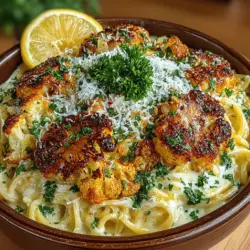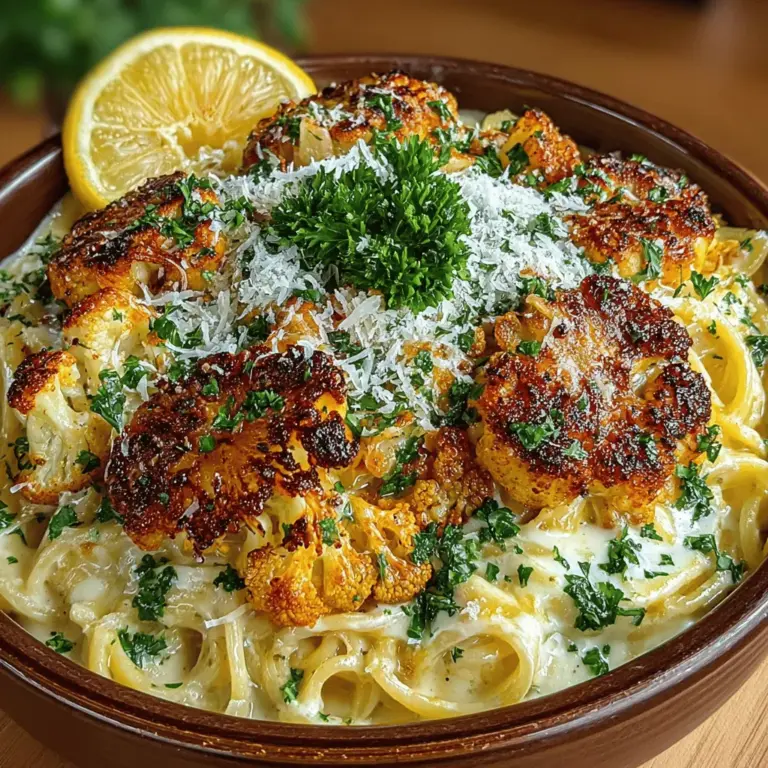Creamy Roasted Garlic Cauliflower Pasta
In the realm of pasta dishes, few recipes manage to strike the perfect balance between comfort and health as well as Creamy Roasted Garlic Cauliflower Pasta. This delectable dish combines the earthy flavors of roasted garlic and cauliflower, resulting in a creamy sauce that envelops pasta in a luscious embrace. Not only does it serve as an enticing option for vegetarians and vegans alike, but it also caters to those seeking a comforting meal that’s quick and easy to prepare, making it ideal for busy weeknights or leisurely weekend dinners.
At its core, this recipe celebrates the versatility of whole foods. By harnessing the natural sweetness of roasted cauliflower and the robust flavor of garlic, each bite becomes a testament to how simple ingredients can come together to create something genuinely delicious. Whether you’re a long-time vegan or simply looking to incorporate more plant-based meals into your diet, this pasta dish promises to please every palate.
Understanding the Ingredients
To prepare this creamy pasta, it’s essential to understand the role of each key ingredient. Each component contributes not only to the overall flavor but also to the texture and nutritional profile of the dish.
– Cauliflower: This humble vegetable is a powerhouse of nutrition. Low in calories and high in vitamins C and K, cauliflower is also an excellent source of fiber. Its versatility allows it to take on various flavors, but when roasted, it develops a sweet, nutty profile that enhances the dish. The caramelization that occurs during roasting brings out its best qualities, making it an ideal base for a creamy sauce.
– Garlic: Renowned for its robust flavor and numerous health benefits, garlic is a staple in many cuisines. When roasted, garlic becomes sweet and mellow, losing its sharpness and instead imparting a rich, buttery flavor to the sauce. Packed with antioxidants and known for its anti-inflammatory properties, garlic not only elevates the taste of this dish but also adds a healthful punch.
– Olive Oil: The quality of olive oil can significantly impact the flavor of your dish. Extra virgin olive oil is the best choice for this recipe, as it contains healthy fats and antioxidants. Its fruity and peppery notes complement the roasted vegetables beautifully, providing a rich mouthfeel that harmonizes with the creaminess of the sauce.
– Pasta Choices: The type of pasta you choose can alter the texture of the dish. From traditional spaghetti to gluten-free options like rice or quinoa pasta, each variety offers its unique qualities. For a more rustic feel, consider using whole grain pasta, which adds a nutty flavor and additional fiber.
– Cream Options: The creamy element of this dish can come from various sources. Heavy cream offers a rich texture that’s hard to beat, but for those preferring a dairy-free alternative, coconut cream provides a luscious consistency with a hint of sweetness. Each option offers a different flavor profile, allowing you to tailor the dish to your dietary preferences.
– Nutritional Yeast: This ingredient is a favorite among vegans for its cheesy flavor and nutritional benefits. Packed with B vitamins and protein, nutritional yeast adds an umami depth to the sauce, making it taste indulgent without the need for dairy.
– Lemon Juice: The acidity of lemon juice serves as a counterbalance to the creaminess of this dish. A splash of lemon brightens the sauce, enhancing the overall flavor and preventing it from feeling too heavy. It’s a small addition that makes a significant difference.
– Garnishes: Fresh parsley not only adds a pop of color but also brings a fresh, herbal note to the dish. For those who enjoy cheese, freshly grated Parmesan adds a sharp, salty flavor that complements the creamy sauce beautifully.
Step-by-Step Preparation
Now that we’ve explored the essential ingredients, let’s dive into the preparation process, ensuring that you can replicate this delightful dish in your own kitchen with ease.
Roasting the Vegetables
The first step in creating Creamy Roasted Garlic Cauliflower Pasta is to roast the cauliflower and garlic. This process is crucial, as roasting enhances the flavors of these ingredients, turning them into the star of the dish.
1. Preheat the Oven: Start by preheating your oven to 400°F (200°C). A properly heated oven ensures that the vegetables roast evenly and develop a nice caramelization.
2. Prepare the Cauliflower: While the oven is heating, wash and chop the cauliflower into bite-sized florets. This size allows for even cooking and makes it easier to blend later.
3. Garlic Prep: Take a head of garlic and slice off the top to expose the individual cloves. Drizzle a little olive oil over the exposed cloves and wrap the head in aluminum foil. This method allows the garlic to steam and caramelize perfectly, resulting in a sweet, buttery flavor.
4. Toss with Olive Oil: In a large mixing bowl, combine the cauliflower florets with a generous drizzle of extra virgin olive oil, salt, and pepper. Toss everything together until the florets are well-coated. This step is essential, as it helps achieve a crispy exterior while maintaining tenderness inside.
5. Roast: Spread the cauliflower florets on a baking sheet in a single layer to promote even roasting. Place the wrapped garlic bulb on the same sheet. Roast in the preheated oven for about 25-30 minutes, or until the cauliflower is golden brown and tender. Make sure to stir the florets halfway through cooking to ensure they roast evenly.
As the vegetables roast, the kitchen will fill with an irresistible aroma, setting the stage for the creamy pasta that’s about to unfold. Once the cauliflower is fork-tender and the garlic is soft and caramelized, you’re ready to move on to the next steps of preparing your creamy sauce and combining it all with your choice of pasta. Stay tuned for the continuation of this recipe, where we will blend the roasted goodness into a luxurious sauce that will coat your pasta perfectly.
{{image_2}}
Cooking the Pasta
Cooking the perfect pasta is essential for achieving a delightful creamy roasted garlic cauliflower pasta. The key to pasta that complements your sauce beautifully is to cook it al dente. This Italian term translates to “to the tooth,” signifying that the pasta should be firm when bitten into, providing a satisfying texture that holds its shape even after being mixed with the sauce.
To cook your pasta, start by bringing a large pot of salted water to a rolling boil. The salt not only enhances the pasta’s flavor but also helps it cook evenly. Once the water is boiling, add your pasta and follow the package instructions for the cooking time, usually around 8 to 12 minutes, depending on the type of pasta you choose. Remember to taste the pasta a minute or two before the suggested cooking time to ensure it reaches the desired doneness.
An essential tip for making your sauce creamy is to reserve some of the pasta water before draining it. This starchy water is a secret weapon in achieving the perfect sauce consistency. The starch helps to bind the sauce to the pasta, adding an extra layer of creaminess and flavor. Simply use a measuring cup to scoop out about a cup of pasta water before draining. Set it aside, and you can adjust the sauce’s thickness later with this liquid.
Making the Creamy Sauce
Now it’s time to create the creamy sauce that will elevate your pasta dish. After roasting your garlic and cauliflower, the next step is to mash these ingredients to form a smooth and creamy base. Begin by transferring the roasted cauliflower and garlic to a high-speed blender or food processor. Add a splash of reserved pasta water, a drizzle of olive oil, and a squeeze of lemon juice for brightness.
Blend the mixture until smooth and creamy. You can adjust the thickness of your sauce by adding more reserved pasta water, a little at a time, until you reach your desired consistency. If you prefer a thicker sauce, you might want to blend it less or add fewer liquids. Taste the mixture and season it with salt and pepper, ensuring the flavors come together beautifully.
For an extra layer of richness, consider adding a dollop of nutritional yeast or a spoonful of cream cheese for a non-vegan option. Nutritional yeast provides a cheesy flavor without the dairy, perfect for vegan adaptations.
Combining Pasta and Sauce
Combining the pasta with the creamy sauce is a critical step. In a large mixing bowl or back in the pot you used to cook the pasta, add the drained pasta and pour in the creamy sauce. It’s essential to mix the two thoroughly, ensuring every strand of pasta is coated with the rich sauce. If the sauce seems too thick, gradually incorporate more reserved pasta water until you achieve a creamy, luscious consistency that clings to the pasta.
Taste the final dish and adjust the seasoning, adding more salt, pepper, or even a sprinkle of parmesan cheese if desired. This step not only ensures that your pasta is seasoned correctly but also allows you to personalize the dish to your taste.
Garnishing and Serving
Presentation is key when it comes to enjoying your creamy roasted garlic cauliflower pasta. To enhance its visual appeal, consider garnishing with a sprinkle of freshly chopped parsley or basil. These vibrant herbs add a pop of color and a fresh aroma that complements the creamy sauce. You can also add a generous grating of parmesan cheese or a drizzle of extra virgin olive oil for an added touch of elegance.
Serve the pasta in shallow bowls to showcase its creamy texture, and consider pairing it with a simple green salad or crusty bread for a complete meal.
Nutritional Benefits of the Dish
This creamy roasted garlic cauliflower pasta is not only delicious but also packed with nutritional benefits that make it a great choice for a balanced diet.
Cauliflower
Cauliflower is a low-calorie, nutrient-dense vegetable that is rich in vitamins C, K, and B6, as well as folate and fiber. It’s known for its antioxidant properties and can help reduce inflammation in the body. Additionally, cauliflower is an excellent source of choline, a nutrient that plays an essential role in brain health.
Olive Oil
The heart-healthy fats from olive oil are another benefit of this dish. Olive oil is known for its monounsaturated fats, which can help lower bad cholesterol levels and reduce the risk of heart disease. It also contains antioxidants and anti-inflammatory properties, making it a staple in healthy cooking.
Garlic
Garlic not only adds flavor but also brings numerous digestive benefits. It’s been shown to have antimicrobial and anti-inflammatory properties, supporting immune function and overall health. Garlic can also enhance the flavor of dishes without the need for excessive salt, making it a great addition to any recipe.
Dietary Substitutions
For those with dietary restrictions, this recipe is easily adaptable. If you’re looking to make it gluten-free, simply swap regular pasta for your favorite gluten-free variety. For a vegan option, use nutritional yeast instead of cheese and ensure that the pasta is egg-free. You can also add plant-based proteins, such as chickpeas or lentils, to boost the dish’s nutritional profile without sacrificing flavor.
Variations and Customizations
The beauty of creamy roasted garlic cauliflower pasta lies in its versatility. Here are some suggestions for customizing the recipe to suit different tastes or dietary needs:
Add-Ins
Consider incorporating additional vegetables to enhance the nutritional value and flavor of the dish. Spinach or kale can add a pop of color and are excellent sources of vitamins and minerals. Peas can introduce a touch of sweetness, while grilled chicken or shrimp can add protein for those who prefer a meatier dish.
Spice It Up
For those who enjoy a bit of heat, adding red pepper flakes can elevate the dish to a new level of flavor. Fresh herbs like thyme or rosemary can also enhance the overall taste profile, adding complexity to the creamy sauce.
Vegan Adaptations
To make the dish fully vegan while maintaining its creaminess, opt for coconut cream or cashew cream as a base instead of traditional cheese. Soaking cashews in water and blending them with nutritional yeast and garlic can create a rich and flavorful cream that perfectly complements the pasta.
Conclusion
Creamy roasted garlic cauliflower pasta is an accessible and nourishing meal that can be prepared with minimal effort. Its rich flavors and creamy texture make it a delightful choice for both weeknights and special occasions. As you experiment with the recipe, don’t hesitate to make it your own by incorporating your favorite vegetables, proteins, or spices. This dish celebrates the simplicity and versatility of cauliflower, elevating it to a star ingredient in your cooking repertoire. Enjoy this delicious pasta dish, knowing that you’re nourishing your body with wholesome ingredients while delighting your taste buds.


